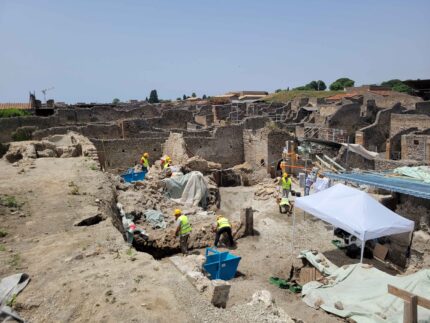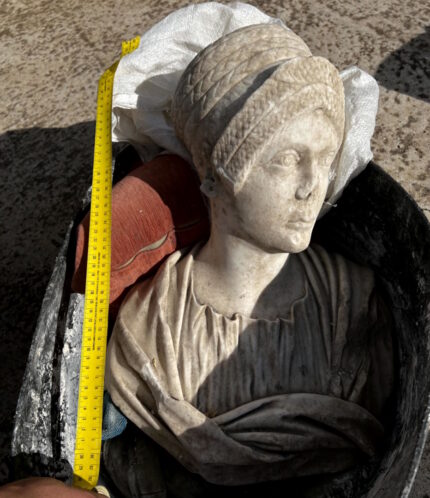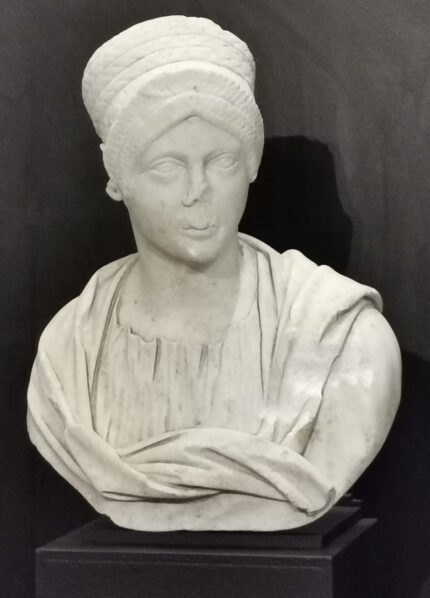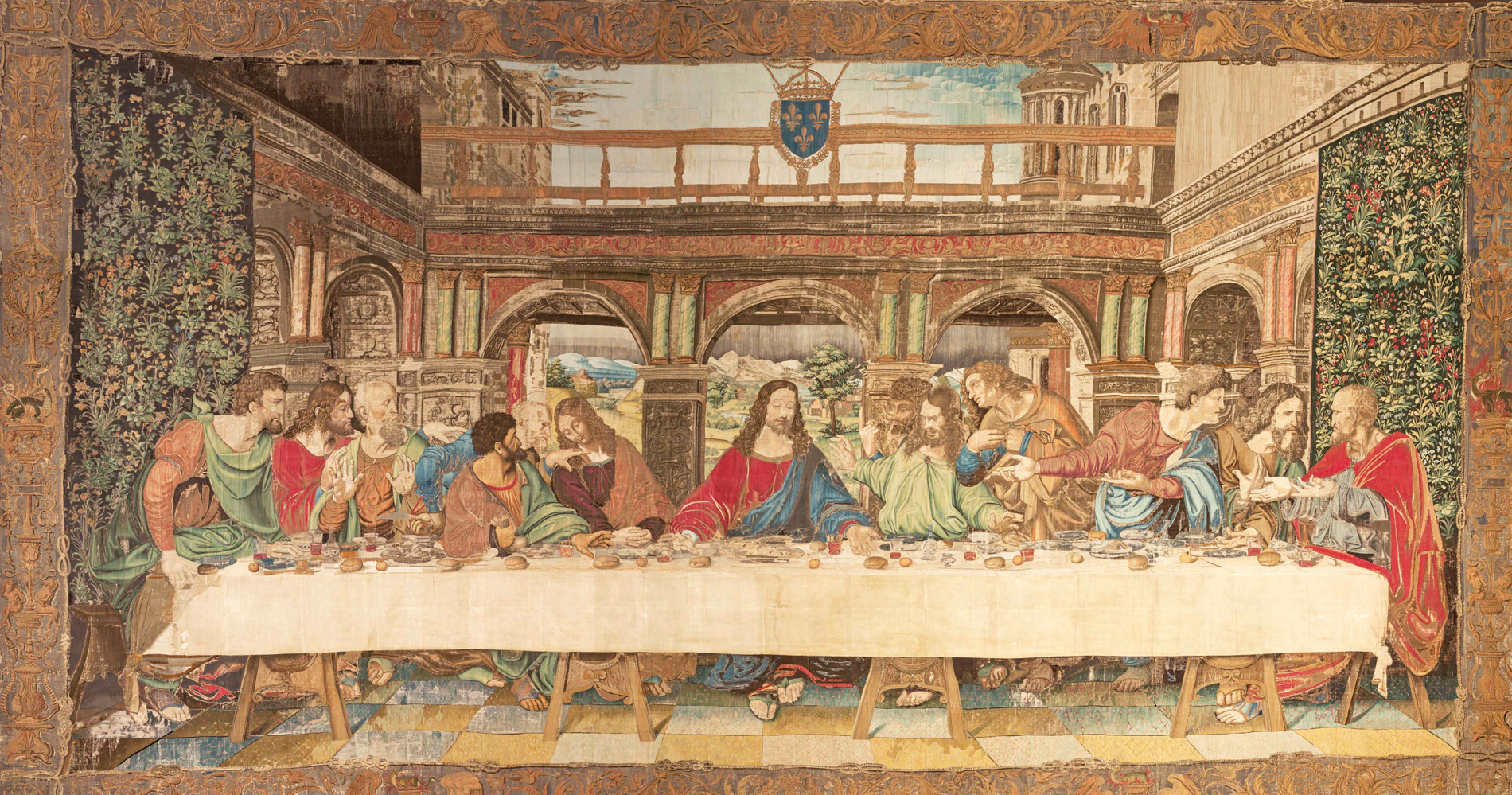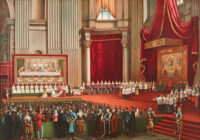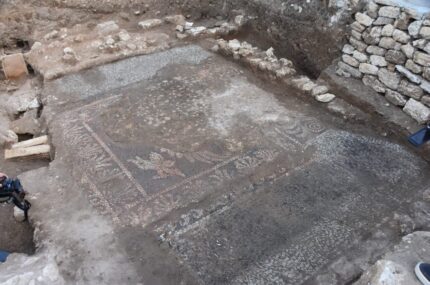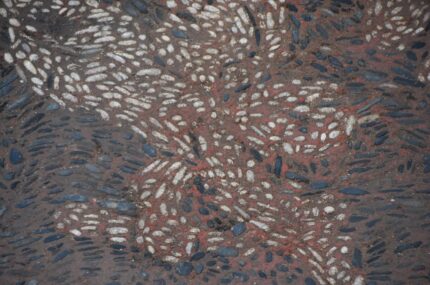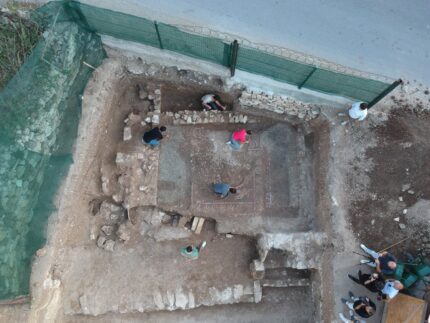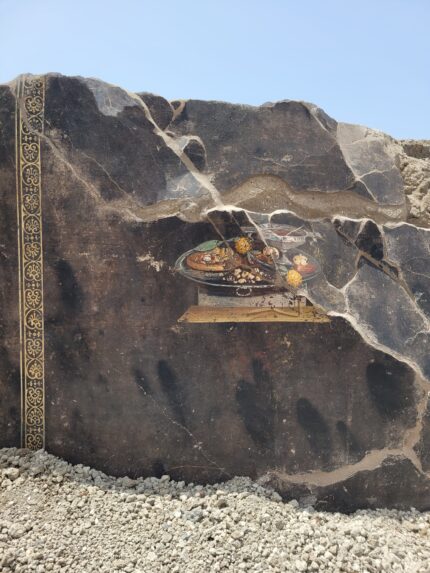 The excavation of a block of houses in Regio IX of Pompeii has uncovered a wall painting of a still life of food and drink featuring what looks very much like a pizza. It is not a pizza, of course, as tomatoes and mozzarella didn’t even exist in Italy when the fresco was painted 2,000 years ago. It’s actually a round, flat focaccia topped with fruits and spices and what may be a pesto-like herb cheese spread known as moretum. The focaccia is shown on a silver tray next to a silver kantharos of wine. Dried and fresh fruits are also on the tray, among them two dates, a pomegranate, a fig and a garland of yellow arbutus berries.
The excavation of a block of houses in Regio IX of Pompeii has uncovered a wall painting of a still life of food and drink featuring what looks very much like a pizza. It is not a pizza, of course, as tomatoes and mozzarella didn’t even exist in Italy when the fresco was painted 2,000 years ago. It’s actually a round, flat focaccia topped with fruits and spices and what may be a pesto-like herb cheese spread known as moretum. The focaccia is shown on a silver tray next to a silver kantharos of wine. Dried and fresh fruits are also on the tray, among them two dates, a pomegranate, a fig and a garland of yellow arbutus berries.
A passage in Virgil’s The Aeneid describes the Trojan refugees eating a focaccia similar to this one when they reach the coast of Lazio. It’s about as appetizing a meal as you would think, ie, barely edible. From Book VII, verses 128-136:
Aeneas, handsome Iulus, and the foremost leaders,
settled their limbs under the branches of a tall tree,
and spread a meal: they set wheat cakes for a base
under the food (as Jupiter himself inspired them)
and added wild fruits to these tables of Ceres.
When the poor fare drove them to set their teeth
into the thin discs, the rest being eaten, and to break
the fateful circles of bread boldly with hands and jaws,
not sparing the quartered cakes, Iulus, jokingly,
said no more than: ‘Ha! Are we eating the tables too?’
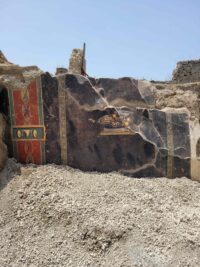 The hard focaccia topped with fruits may not have been the height of deliciousness, but the food on a silver tray represents the Greek concept of Xenia, hospitality offered to all visitors creating a powerful, ritualized bond of friendship between host and guest. The offering of food was an essential element, one frequently captured in the art of Greece and Rome. Vitruvius writes about Xenia, as a hospitality concept and as artwork, in Book VI 7,4 of De Architectura:
The hard focaccia topped with fruits may not have been the height of deliciousness, but the food on a silver tray represents the Greek concept of Xenia, hospitality offered to all visitors creating a powerful, ritualized bond of friendship between host and guest. The offering of food was an essential element, one frequently captured in the art of Greece and Rome. Vitruvius writes about Xenia, as a hospitality concept and as artwork, in Book VI 7,4 of De Architectura:
On the right and left, moreover, are small sets of apartments, each having its own door, triclinium, and bed-chamber, so that on the arrival of guests they need not enter the peristylium, but are received in rooms (hospitalia) appropriated to their occupation. For when the Greeks were more refined, and possessed greater wealth, they provided a separate table with triclinia and bed-chambers for their guests. On the day of their arrival they were invited to dinner, and were afterwards supplied with poultry, eggs, herbs, fruits, and other produce of the country. Hence the painters gave the name of Xenia to those pictures which represent the presents made to guests. Masters of families therefore, living in these apartments, were quite, as it were, at home, being at liberty to do as they pleased therein.
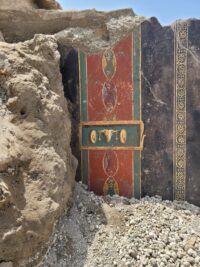 Depictions of Xenia were popular motifs in Roman visual arts, particularly in the Pompeiian Fourth Style (aka the Intricate Style) of mural painting. There are about 300 murals of food offerings known from the cities buried in the 79 A.D. eruption of Vesuvius (Pompeii, Herculaneum, Oplontis, etc.). This example is notable for the high quality of its execution.
Depictions of Xenia were popular motifs in Roman visual arts, particularly in the Pompeiian Fourth Style (aka the Intricate Style) of mural painting. There are about 300 murals of food offerings known from the cities buried in the 79 A.D. eruption of Vesuvius (Pompeii, Herculaneum, Oplontis, etc.). This example is notable for the high quality of its execution.
It was discovered in the atrium of a house in the Insula 10 block of Regio IX. The house with an attached bakery was first explored between 1888 and 1891, but only a small part of it. Excavations resumed this January with the goal of stabilizing the structures excavated in the 19th century and largely neglected since then.
